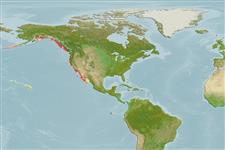Stelletta clarella De Laubenfels, 1930
Thick white prickly sponge| Native range | All suitable habitat | Point map | Year 2050 |

|
| This map was computer-generated and has not yet been reviewed. |
| Stelletta clarella AquaMaps Data sources: GBIF OBIS |
Google image |
No photo available for this species.
Classification / Names Common names | Synonyms | CoL | ITIS | WoRMS
Demospongiae | Tetractinellida | Ancorinidae
Environment: milieu / climate zone / depth range / distribution range Ecology
Sessile; depth range 50 - 95 m (Ref. 3699). Subtropical
Distribution Countries | FAO areas | Ecosystems | Occurrences | Introductions
Eastern Pacific and Eastern Atlantic: USA, Canada and Chile. Subtropical to temperate.
Length at first maturity / Size / Weight / Age
Maturity: Lm ? range ? - ? cm
Life cycle and mating behavior Maturity | Reproduction | Spawning | Eggs | Fecundity | Larvae
Main reference
References | Coordinator | Collaborators
Castilla, J.C., M. Uribe, N. Bahamonde, M. Clarke, R. Desqueyroux-Faúndez, I. Kong, H. Moyano, N. Rozbaczylo, B. Santelices, C. Valdovinos and P. Zavala 2005 Down under the southeastern Pacific: marine non-indigenous species in Chile. Biological Invasions 7:213-232. (Ref. 3699)
IUCN Red List Status
(Ref. 130435: Version 2025-1)
CITES status (Ref. 108899)
CMS (Ref. 116361)
Threat to humans
Human uses
| FishSource |
Tools
More information
Diet composition
Food consumption
Predators
Max. ages / sizes
Length-weight rel.
Length-length rel.
Length-frequencies
Mass conversion
Abundance
Internet sources
BHL | BOLD Systems | CISTI | DiscoverLife | FAO(Publication : search) | Fishipedia | GenBank (genome, nucleotide) | GloBI | Gomexsi | Google Books | Google Scholar | Google | PubMed | Tree of Life | Wikipedia (Go, Search) | Zoological Record


